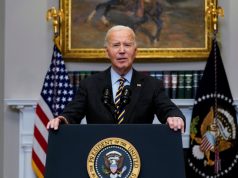
WASHINGTON— The humanitarian catastrophe in Gaza has prompted calls for Washington to put conditions on the billions of dollars in military funding and other assistance it provides to Israel, which has received more U.S. foreign aid since World War Two than any other country.
The following are details of U.S. support for Israel as it fights Hamas militants in Gaza.
What aid is mandated by law?
In 2016, the U.S. and Israeli governments signed a third 10-year Memorandum of Understanding, covering the period from Oct. 1, 2018 to Sept. 30, 2028. The MOU provides a total of $38 billion in military aid over the 10 years, $33 billion in grants to buy military equipment and $5 billion for missile defense systems.
What advanced weapons systems does Israel get?
Israel is the first international operator of the F-35 Joint Strike Fighter, considered the most technologically advanced fighter jet ever made. Israel is in the processes of buying 75 F-35s and – as of last year – had taken delivery of 36, paying for them with U.S. assistance.
The United States has also helped Israel develop and arm its Iron Dome short-range rocket defense system, developed after the 2006 war between Israel and Lebanon-based Hezbollah. The United States has repeatedly sent Israel hundreds of millions of dollars to help replenish its interceptor missiles.
Washington has also helped fund the development of Israel’s “David’s Sling” system, designed to shoot down rockets fired from 100 kilometers to 200 km (62 miles to 124 miles) away.
Will Israel get more for its campaign against Hamas?
Last year, President Joe Biden asked Congress to approve a $95 billion supplemental spending bill that included $14 billion for Israel, in addition to $60 billion for Ukraine, support for Taiwan and billions in humanitarian assistance.
That package passed the Senate with 70% support in February but has been blocked in the House, whose Republican leaders will not call it up for a vote, largely because of their objection to further funding for Ukraine. It also faces resistance from a handful of left-leaning Democrats who object to sending more money to Israel while it pursues a military campaign that has killed more than 30,000 civilians in Gaza, according to Palestinian health officials.
How else does Washington support Israel?
The United States has long used its veto power on the U.N. Security Council to block resolutions seen as critical of Israel. Earlier in the six-month-long war in Gaza, it vetoed measures that included calls for an immediate ceasefire.
To pass in the Security Council, a resolution needs at least nine votes in favor and no veto by the U.S., France, Britain, Russia or China.
Late last month, Washington dropped its traditional protection of Israel by abstaining from a vote on a resolution demanding a ceasefire, instead of casting a veto, although it described the brief text as ‘non-binding.’
Washington has taken Israel’s side elsewhere. Former Republican President Donald Trump withdrew the United States from the world’s most important human rights body, the U.N. Human Rights Council, in protest of its criticism of Israel’s treatment of Palestinians.
Also under Trump, it left the United Nations Educational, Scientific and Cultural Organization, partly because of what his administration called a bias against Israel.
Trump also reversed decades of U.S. policy in 2017 by recognizing Jerusalem as Israel’s capital. The status of Jerusalem – home to sites holy to the Muslim, Jewish and Christian religions – has been one of the biggest obstacles to reaching a peace agreement between Israel and the Palestinians.
— Reporting by Patricia Zengerle; Additional reporting by Mike Stone; Editing by Don Durfee and Bill Berkrot









